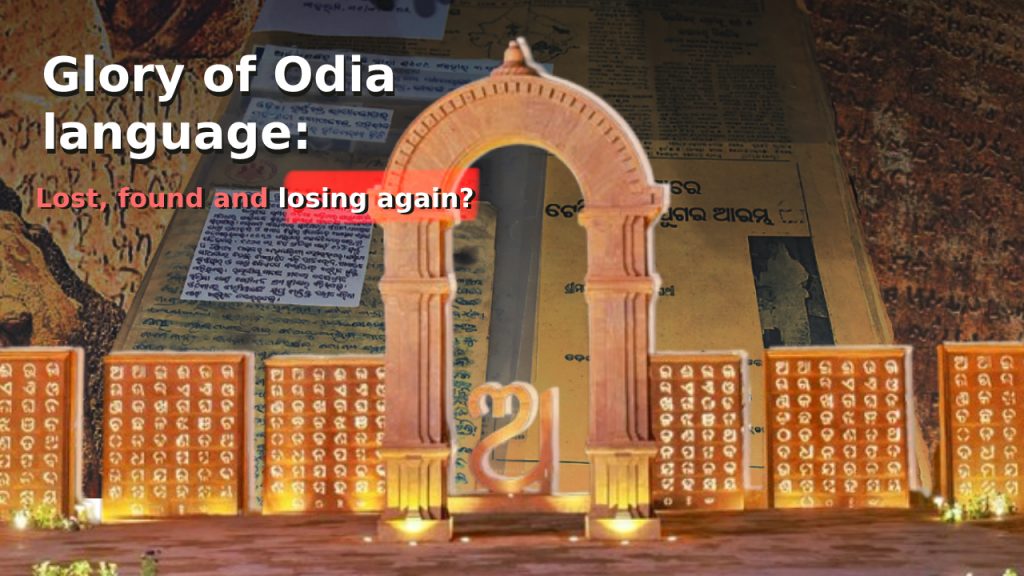Among many intelligentsia fighting for the existence of Odia identity during the 19th and 20th centuries, Fakir Mohan Senapati was a prominent name. Often regarded as the father of Odia nationalism and modern Odia literature, he used Baleswari dialect in many of his works such as ‘Chha Mana Atha Guntha’, the first Odia short story ‘Rebati’ among others to shed light on socio-cultural conditions of Odisha and used his literature for the language movement.
Over time, the Odia language movement gained momentum, marked by key events such as the restoration of Odia as the official language in the first half of the 20th century, and the enactment of the Orissa Official Language Act in 1954. Despite numerous challenges, the Odia language persevered, culminating in its recognition as a classical language by the Government of India in 2014.
During the movement, Senapati, along with other prominent figures such as Gourishankar Ray, Madhusudan Das, Gopabandhu Das among others, fought to preserve Odia as an independent language and resisted attempts to replace it with Bengali in government offices and schools.
Fast forward to today, eminent poet and President of the Odisha Sahitya Akademi, Hrushikesh Mallick expresses concern over the dominance of Bengali, Hindi, and Telugu in the northern, western and southern bordering areas of Odisha, respectively. “These languages are aggressively posing a threat to the Odia language,” he says.
Mallick, along with writer Dileswar Rana — who won Kendriya Sahitya Akademi Yuva Purashkar-2023 — agrees that in the rapidly evolving digital landscape, Odia language has not adapted well to technology making it less user-friendly and unable to flourish like other regional languages such as Tamil, Malayalam, Kannada and Bengali.
Conversations with these two notable personalities of different generations point to the fact that Odia language is facing many issues today that need to be addressed.
State of Odia language in digital age
In today’s digital era, the internet has become an integral part of our lives, enabling us to perform various tasks online – from accessing information to purchasing goods and services. A report titled ‘Google’s Year in Search 2020: India for Determined Progress’ revealed that in India, nearly 90% of internet users prefer to use their native language when searching and conducting online activities. However, the question arises: how well is Odia language adapting to this digital landscape?
The Odisha Sahitya Akademi president highlights various issues within the Odia script/alphabate writing system, particularly in the digital medium. He emphasises the inadequacy of software developed for the Odia language, citing a lack of language tools like thesaurus (for search of words), spelling and grammar correction, unlike other regional languages.
“In the age of IT,” Mallick asserts, “we need to make the Odia language adaptable to computers, develope software to facilitate digital writing and ensure ease of use.”
Mallick says the absence of a universally accepted or standardised writing system for the Odia language leads to diverse and varying ways of writing the same words among users (e.g. ସମ୍ପୂର୍ଣ and ସଂପୂର୍ଣ). He stresses the importance of unifying/ standardising the language, suggesting a standardised writing system (‘banana byabasta’ or ‘banana bidhi’) similar to English and Devanagari.
Mallick points out inconsistencies in Odia scripts and punctuation across different software platforms. He warns that without addressing these issues, people may resort to writing Odia sentences using English or Roman alphabet, which could jeopardise the language in the long-term.
To address these challenges, Mallick calls for development of better digital tools and increased government intervention through the formation of a committee for language standardization (he hints that the government is considering forming a committee, but the question is how soon it will happen) and a concerted effort to promote the use of Odia scripts/ letters.
Role of newspapers and books
Recognising the pivotal role of newspapers in Odia mass communication, Mallick proposes that news organisations should develop and implement comprehensive dictionaries, glossaries and standardised writing guidelines. This measure aims to foster script uniformity and cohesion within the Odia language. He draws inspiration from the ‘Anandabazar Patrika’ – a prominent Bengali newspaper that has successfully adopted such practices.
Moreover, the poet emphasises the literature’s significance in language promotion and advocates for government support in identifying and nurturing talented writers from grassroots levels, rather than solely rewarding established figures who are already honoured with prestigious awards.
Proposed solutions
In order to strengthen Odia language, Mallick recommends making it a compulsory language subject at least until Class-V, drawing inspiration from states like Tamil Nadu and Karnataka. At the societal level, he adds that parents should encourage their children to speak in Odia. At the university level, he suggests facilitating translation to and from Odia to enrich literature and academic discourse.
The way forward
When asked about the role of young writers and readers in Odisha, Mallick stresses the need to encourage budding talents from school levels and bring them into limelight.
Dileswar, who is among the most successful young talents, stresses on the significance of considering the readers’ interests while writing. Additionally, he emphasises the need for concise writing, enabling readers to consume the content time-efficiently, particularly in the age of busy schedules.
Dileswar, who got the Sahitya Akademi Yuva Puraskar-2023 for his book ‘Senrra’ (which is a local term used in Kalahandi meaning ‘shamelessly nonchalant’), says, “If we want to enrich our language, then we have to welcome every regional language terms from different parts of Odisha.”
The young writer further says that Fakir Mohan Senapati – whose contributions to Odia literature are priceless — has vastly used the Baleswari dialect in his writings such as ‘Randipua Ananta’, ‘Daka Munsi’ among others. Similarly, Dileswar suggests that we can follow the footsteps of Senapati and include words from different parts of the state to enrich Odia literature.
By Harihara Kar, OP
